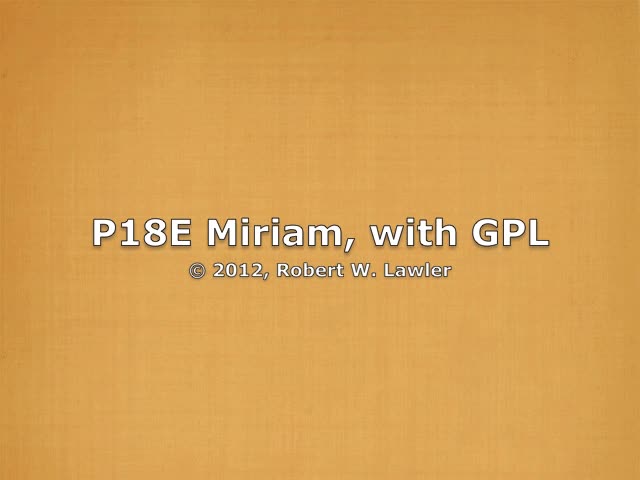
P18E Clip Notes
| Notes:n:nn | by Analyst, 10/19/2024 |
| Setting,Props | Brookline, Carriage House: |
| Actors,Aims | Peggy, Miriam and Mom; Bob on camera. |
| Episode A: | Bob: What are you saying, Miriam? Miriam: I’m whispering. Bob: Why? Do you whisper when you play with Peggy? {Miriam:No} well, that’s what you… |
| Episode B: | Miriam: Okay… Clap, hands, here comes Charlie (teddy bear). [a routine for playing with a baby, from her Grandmother] Clap, hands. Here comes Peggy. Clap, hands. Here comes Peggy, and Charlie, now… Hey… He’s goin’ up there. |
| Episode C: | Miriam: (to Mom) [picking up the clown] What’s his name ? Mom: He doesn’t have one… we just call him ‘the clown’. Miriam: Clap hands, here comes Clowny now. Clap hands, here comes clowny now… [When Peggy does not grasp either toy, Miriam presents both and asks] Which one do you like better? [with no clear decision, Miriam poses both toys on Peggy’s lap] Okay, he’ll sit with you. I think he’ll sit there. She’s throwing her toys at floor (??). |
| Episode D: | Miriam: Okay, Peggy, [bringing up a toy giraffe-“abacus”] can you count yet? One, two, three, four, five. See? (speaking more slowly) One, two, three, four, five. Bob: You don’t [aborted interjection]… |
| Episode E: | Bob: What other games do you play with Peggy, Miriam? You don’t always play with toys. Miriam: I know. [Exit, end of clip] |
| Episode | |
| Summary by AI |
Miriam begins by whispering and is asked why she’s whispering. She’s asked if she whispers when playing with Peggy; she says no. Miriam initiates a clapping routine: “Clap, hands, here comes Charlie,” referencing a teddy bear. She notes the routine comes from Peggy’s grandmother and includes Peggy and Charlie. Observes someone “going up there,” possibly moving a toy or person out of frame. Picks up a clown toy, asks its name; told it’s just called “the clown,” then includes it in the clapping routine. When Peggy doesn’t grasp a toy, Miriam offers both and asks which she prefers. With no clear choice, Miriam places the toys on Peggy’s lap, commenting that they’ll sit with her. Introduces a giraffe “abacus” toy and counts slowly from one to five, encouraging Peggy. An adult asks what other games Miriam plays with Peggy, noting they don’t always use toys; clip ends. |
| Narrative by AI |
A quiet moment unfolds as an adult and a child settle into a familiar rhythm of play. The exchange begins softly, with a whispered question and a curious response, setting a gentle tone. Names and roles emerge—Peggy as the baby, Miriam as the engaged playmate—and the setting feels intimate, focused on connection as much as on activity. There’s no rush, just attentive presence and small invitations to interact. Play takes shape through a simple routine: clapping hands and introducing toys with a sing-song cadence. A teddy bear named Charlie appears, followed by a clown who, amusingly, “doesn’t have a name.” The ritual is both playful and purposeful, using repetition and rhythm to capture attention. It’s the kind of game that many families pass down—predictable enough to be comforting, yet flexible enough to invite participation. Choice becomes part of the experience as Miriam asks which toy Peggy prefers. With no clear selection, both toys are placed within reach, allowing the child to explore without pressure. This small moment reflects a common dynamic in early play: the balance between offering options and accepting undecidedness. The toys may be tossed to the floor, as babies often do, but the interaction continues, adapting to the child’s cues. A new prop enters—a giraffe abacus—and so does counting. The numbers come slowly, deliberately: one, two, three, four, five. The pacing suggests a teaching moment woven seamlessly into play. There’s no expectation of immediate mastery; the counting is more an introduction than a test, a way to pair sound and rhythm with visual engagement. As the clip winds down, a final question hints at the broader world of their everyday games. The scene captures the essence of early interaction: routines, choices, language, and gentle scaffolding. It’s a reminder that development often happens in small, repeated moments—claps and names, questions and pauses—where curiosity is invited, not demanded, and connection is the foundation of learning. |
| Link Index | Panel P018, Language Development, Object Exploration, Social Interactions |
| Themes, Interplay |
